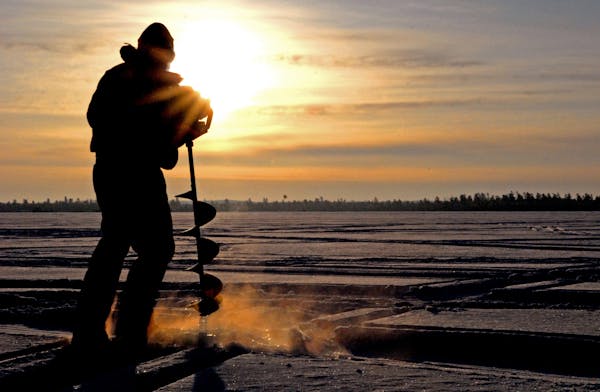Deep in the woods near Walker, Minn., Andrew Seagren was clearing away leaves at the base of a tree so a deer-hunting friend could sit there later.
Then he heard footsteps.
"I looked up and didn't see anything, so I kept clearing the spot, while grunting and bleating [mimicking a deer] with my calls to cover my noise," said Seagren, a 21-year-old student at Bemidji State University. He was taking a break after wolf hunting earlier in the morning. "Then I looked up again and saw a wolf trotting between two wetlands about 60 yards away."
Standing in the open, Seagren raised his rifle and peered through the scope.
And saw nothing.
"My scope was iced up," he said.
He cleared the ice away, shouldered the rifle again, spotted the wolf, now about 100 yards away, and fired. On the last day of Minnesota's early wolf season, Seagren bagged his first-ever Canis lupus.
"I got lucky," he said.
That's an understatement, considering last year only 4 percent of wolf hunters were successful during the early season, which coincides with the state's firearms deer season. Minnesota's second managed wolf season ever is about half over, and hunters and trappers have killed 110 wolves — half of this year's target harvest of 220.
Late-season underway
The Department of Natural Resources is again collecting teeth from harvested wolves and reproductive tracts of female wolves to determine age and the number of pups per litter. None of that information has been compiled yet. Though the DNR has issued 3,300 licenses, about half as many as 2012, the rate of harvest for those hunters appears similar to last year.
"It's hard to draw any conclusions at this point," said Dan Stark, DNR wolf specialist.
About 1,300 hunters and trappers are licensed for the late season, 900 fewer than last year.
The DNR cut the target wolf harvest from 400 a year ago to 220 this year after a survey last winter estimated the state's wolf population at 2,211 — a 24 percent decline from 2008, but that figure didn't include this year's surviving pups. The DNR will use information gathered from radio-collared wolves to make another population estimate this spring.
Meanwhile, the early wolf season ended last month, with 88 wolves killed. The late season, which includes both hunters and trappers, began Saturday and runs through Jan. 31, or until target quotas in the three wolf zones are reached.
Up to 132 wolves can be killed during the late season, and so far the tally is 22 — 10 in the northeast and 12 in the northwest. No wolves have been killed in the east-central zone in either the early or late season.
Stark still expects hunters and trappers will reach the 220-wolf quota.
"Nothing has happened so far to make me think anything different," he said.
Better lucky than good
Seagren grew up in the Twin Cities area and is studying biology and wildlife management at Bemidji State. He is also president of the student chapter of the Wildlife Society.
He hopes to become a wildlife biologist.
"I'd like to work with moose or wolves or deer," he said.
An avid hunter, he applied last year for the late-season wolf season and figures he spent perhaps 20 days afield.
"I hunted hard," he said. But never got a shot.
"It's a challenge," he said of hunting wolves. "They're definitely smarter than any other animal I've hunted. It's also just an excuse to get out in the woods."
He doesn't believe the state's new wolf season will boost whitetail deer numbers, or hurt the wolf population.
"I like seeing them; they're gorgeous animals," he said. A wolf season, he said, "seems like a good management tool."
This year, Seagren applied for the early wolf season, because he will be on an internship in Hawaii in January studying humpback whales. He hunted about 12 days, shot a deer the second weekend of the season, and then solely targeted a wolf.
He knows how difficult it is even to see a wolf, never mind stumbling upon one while moving through the woods.
"I couldn't believe I got it on the last day of the season," he said.
So what does a college student do with a wolf pelt?
"I might get a full-body mount," Seagren said. "I'll maybe put it in our cabin, or maybe my room."
Doug Smith • dsmith@startribune.com

The Twins sell tickets with all-you-can-eat classic concession fare. Are they worth it?
Kansas adds AJ Storr after he led Wisconsin in scoring this season
Butler, Williamson injuries are part of story for Heat-Bulls and Kings-Pelicans play-in finales

